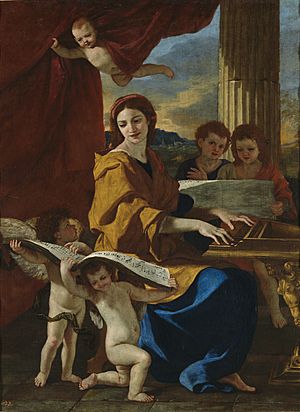Saint Cecilia (Poussin) facts for kids
Saint Cecilia is a famous painting created by Nicolas Poussin between 1627 and 1628. You can see this beautiful artwork at the Prado Museum in Madrid, Spain. The painting shows Saint Cecilia, who is known as the patron saint of music. She is playing a keyboard instrument, which might be a harpsichord. In front of her, two small angels, called cherubs, hold up a scroll with musical notes. In the background, two more angels are singing, and another cherub is pulling back a curtain.
Contents
Who Was Saint Cecilia?
Saint Cecilia is a very important figure in Christian history. She is celebrated as the patron saint of musicians, poets, and even blind people. Many stories say she was a Roman noblewoman who lived in the 3rd century. She was known for her strong faith.
Cecilia is often shown with musical instruments, especially an organ or a harpsichord. This is why she is so connected to music. Her story has inspired many artists, writers, and composers over the centuries.
About the Artist: Nicolas Poussin
Nicolas Poussin was a very important French painter. He lived from 1594 to 1665. Poussin spent most of his life working in Rome, Italy. He is famous for his classical style of painting. This means his art often looked back to the ancient Greek and Roman worlds.
Poussin's paintings usually tell a story. They often feature clear lines, bright colors, and balanced compositions. He painted many religious and mythological scenes. His work greatly influenced other artists for a long time.
What's Happening in the Painting?
Poussin's "Saint Cecilia" is full of interesting details. The painting focuses on Saint Cecilia herself. She is shown in a moment of deep concentration as she plays her instrument. Her expression is calm and peaceful.
The painting has a very musical feel. The angels and cherubs around Cecilia add to this. They seem to be part of a heavenly concert. This shows how important music was to Saint Cecilia's story.
Musical Instruments in Art
The instrument Saint Cecilia is playing is likely a harpsichord. A harpsichord is an old keyboard instrument. It was popular before the piano was invented. When you press a key on a harpsichord, a small quill plucks a string. This makes a bright, clear sound.
Artists often include musical instruments in their paintings. They can show a character's talents or interests. In this painting, the harpsichord highlights Saint Cecilia's special connection to music. It also helps us understand the time period the painting represents.
Angels and Cherubs
You can see several angels and cherubs in the painting. Angels are spiritual beings often shown with wings. They are messengers from heaven. Cherubs are a type of angel, often shown as cute, winged children.
In "Saint Cecilia," the cherubs are helping with the music. One cherub holds a scroll of music for Cecilia. Another cherub is lifting a curtain. This makes the scene feel like a special performance. The angels in the background are singing, adding to the heavenly atmosphere.
Where Can You See It?
Today, "Saint Cecilia" is a treasured artwork at the Prado Museum in Madrid, Spain. The Prado Museum is one of the most famous art museums in the world. It has a huge collection of European art. Many masterpieces from different centuries are kept there.
Seeing the painting in person allows you to appreciate its size and colors. It also lets you see the fine details Poussin included. The Prado Museum is a great place to learn about art history.
See also
 In Spanish: Santa Cecilia (Poussin) para niños
In Spanish: Santa Cecilia (Poussin) para niños
- List of paintings by Nicolas Poussin


